Fanstel Taipei BH661 Bluetooth 4.1 Module User Manual BlueFanBH661 20160930
Fanstel Corporation, Taipei Bluetooth 4.1 Module BlueFanBH661 20160930
Users Manual
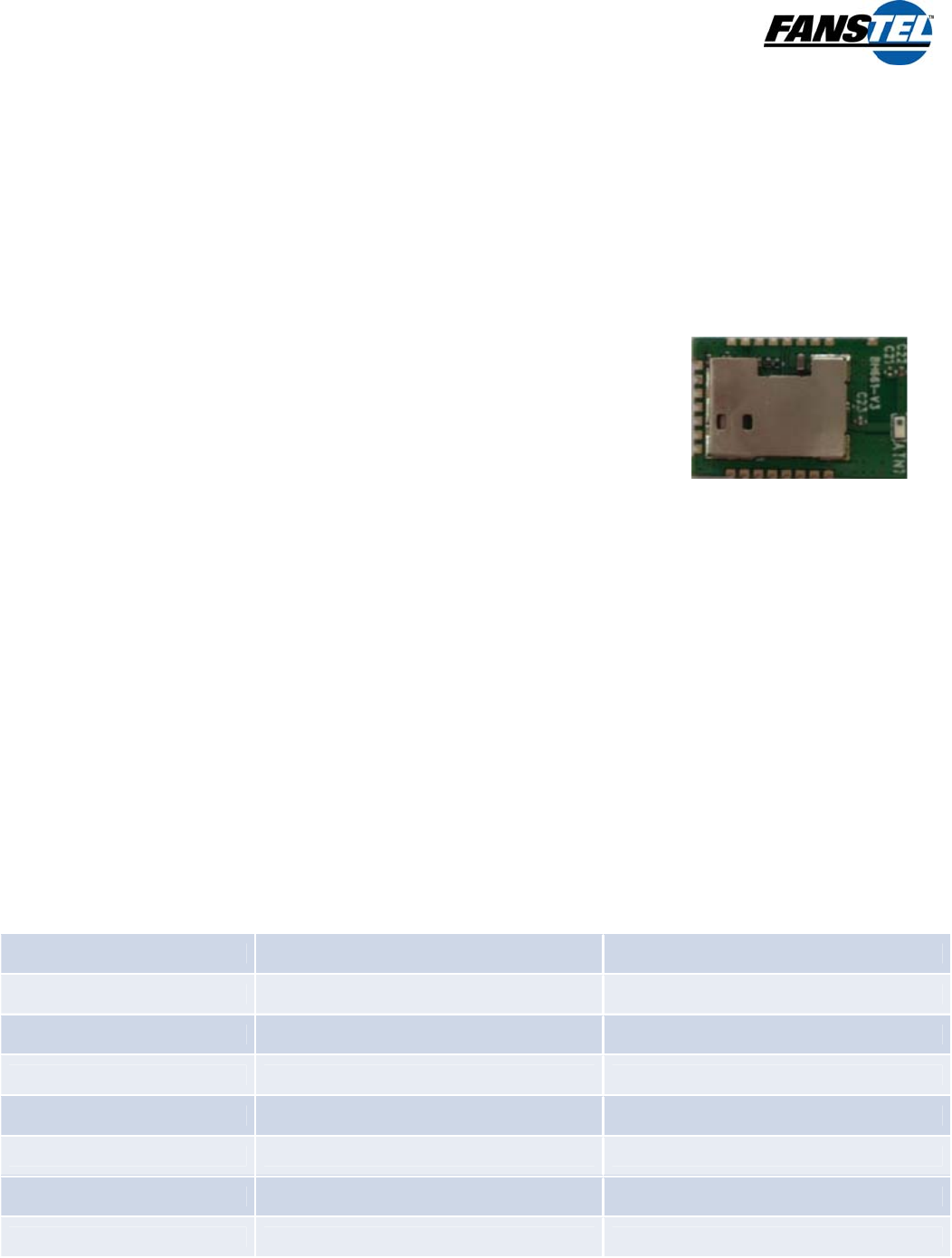
BlueFanBH661C,DualModeBluetoothModuleVer1.00July2016draft
1
BH661 Features
Processor: Toshiba TC35661
Bluetooth Classic and BLE (Dual Mode) Support
On board chip antenna.
Transmitter power +4 dBm; Receiver sensitivity: -91 dBm.
Bluetooth: V4.0, GATT profile with high level API commands.
Bluetooth Classic 2.1 embedded SPP profile with high level API commands
On board masked ROM and SRAM for reliable operation
Host Control Interface (HCI) protocols, UART interface
General Purpose IO
▪ SPI interface
▪ I
2C interface
▪ UART interface, 2400bps to 4.33Mbps
▪ Wake up interface from sleep and deep sleep modes
Operation voltage: 1.8V-3.6V
Current consumption
Operation Temperature: -40oC to +85oC
Dimension: 15.6x8.7mm, LGA (Land Grid Array) package, 58 pins.
Integrated shield to resist EMI
Approval: FCC, pending
Applications:
Access Points
Industrial Control
Medical
Scanners
iOS and Android devices
Wireless sensors
Cable replacement
Instrumentation
Automobile
Sports
Proximity
Headset
Walkie talkie
Ordering Information:
module BH661C-503 BH661C-007, -008
SoC TC35661-503 TC35661-007, -008
antenna Chip Chip
Line of sight range, meters 30 30
sleep clock external external
Sizes, mm 11x16.7x1.9 11x16.7x1.9
Eval board EV-BH661C-503 EV-, -007, -008
FCC ID pending pending

BlueFanBH661C,DualModeBluetoothModuleVer1.00July2016draft
2
IC ID (Canada) pending pending
Availability in production made to order

BlueFanBH661C,DualModeBluetoothModuleVer1.00July2016draft
3
1. Introduction ................................................................................................................................................... 4
2. Product Overview ......................................................................................................................................... 4
3. Hardware Description ................................................................................................................................... 5
Mechanical Drawings of BH661C
Pin Assignments of BH661C
Pin Functions
4. UART Interface ............................................................................................................................................. 6
Features
Flow Control Function
UART Baud Rate Setting
Error Detect Function
5. Bluetooth Features ....................................................................................................................................... 8
BH661C-503
BH661C-008
6. General Device Requirements and Operation ............................................................................................. 9
Absolute Maximum Ratings
Recommended Operating Conditions
Current Consumption
7. Software ....................................................................................................................................................... 10
Information Regarding Software Versions
Software
8. BH661C Evaluation Board .......................................................................................................................... 11
Evaluation Software for Windows PC
Evaluation Software for MAC
Android OS App
iOS App
Evaluation Board Schematics
9. FCC ............................................................................................................................................................. 12
10. Soldering Temperature-Time Profile for Re-Flow Soldering .................................................................... 12
11. Cautions ................................................................................................................................................... 12
12. Packaging ................................................................................................................................................. 15
13. Contact Us ................................................................................................................................................ 16
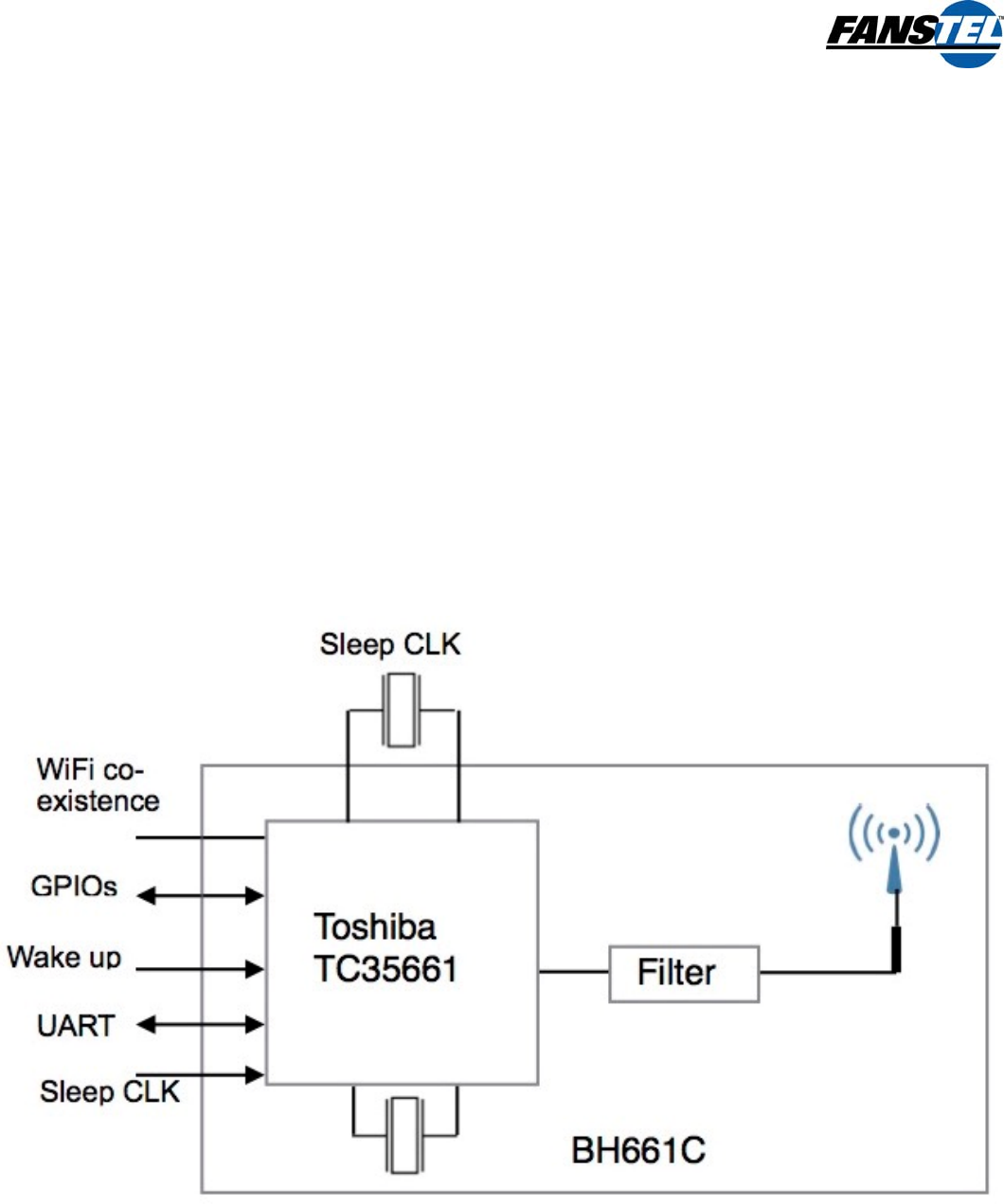
BlueFanBH661C,DualModeBluetoothModuleVer1.00July2016draft
4
1. Introduction
BH661C is a dual mode BLE (Bluetooth Low Energy) and Bluetooth Classic module using Toshiba
TC35661 SOC.
TC35661 provides BluetoothTM HCI (Host Control Interface) function specified in BluetoothTM Core
Specifications. The HCI function allows BH661 to be connected to an external host processor for
Bluetooth applications.
2. Product Overview
The following is a block diagram of Toshiba BH661. It communicates with a host processor via an
UART port. A 26MHz main clock crystal is on board. For lower power consumption in sleep mode, an
external 32.768 KHz clock source is required. This module can be wake up by an external signal
An chip antenna is on board.
For ROM code supporting wide band voice, use I2S interface to connect to an external codec.
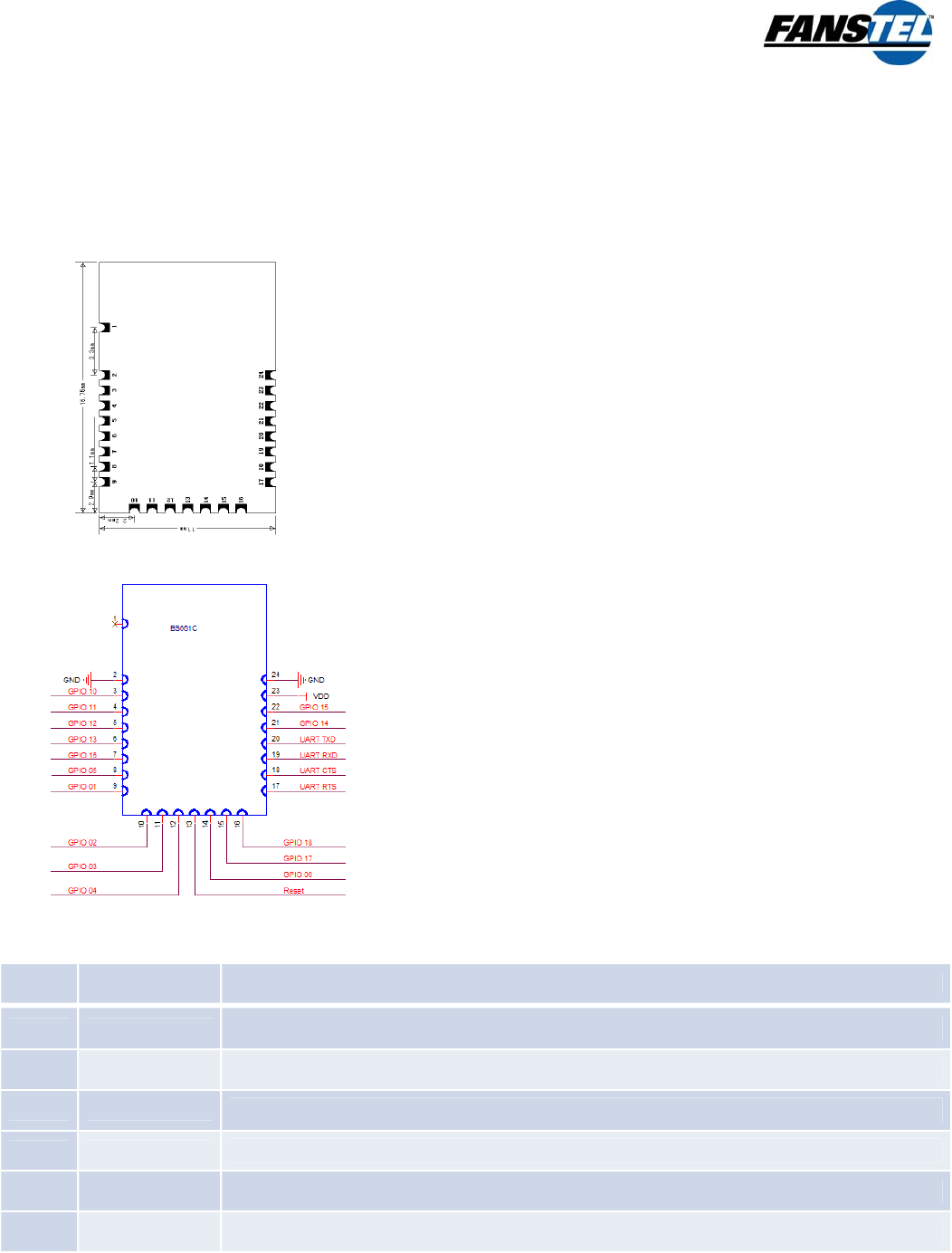
BlueFanBH661C,DualModeBluetoothModuleVer1.00July2016draft
5
3. Hardware Description
Mechanical Drawings of BH661C
The size of BH661C is 11.1x16.7x1.9mm. The mechanical drawing is shown below.
Pin Assignments of BH661C
Pin Functions
Pin Pin name Descriptions
1 NC
2 GND
3 GPIO 10
4 GPIO 11
5 GPIO 12
6 GPIO 13
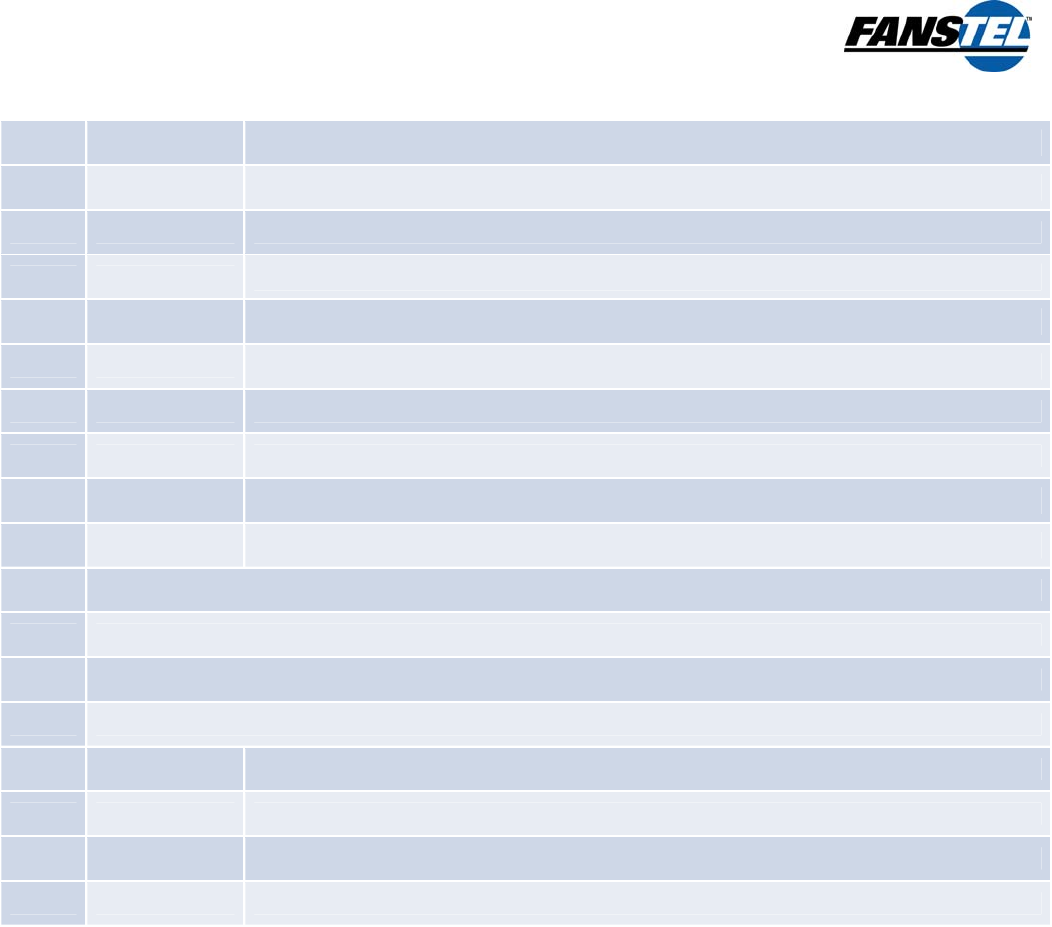
BlueFanBH661C,DualModeBluetoothModuleVer1.00July2016draft
6
7 GPIO 16
8 GPIO 05
9 GPIO 01 GPIO1, set by firmware to Analog to Digital Converter input 0
10 GPIO 02
11 GPIO 03
12 GPIO 04
13 RESET External reset, active low
14 GPIO 00 GPIO 00, set by firmware to WAKE-UP0
15 GPIO 17
16 GPIO 18
17 UART1-RTS
18 UART1-CTS
19 UART1-RX
20 UART1-TX
21 GPIO 14 GPIO 14, set by firmware to SCL
22 GPIO 15 GPIO 15, set by firmware to SDA
23 VDD Power supply, 2.0 to 3.6 V
24 GND Ground
4. UART Interface
Features
• Full duplex 4-wire data transfer: RX, TX, RTSX, CTSX.
• Programmable baud rate:2400 bps to 4.33 Mbps.
Data format:
✦ LSB first
✦ 1 start bit
✦ 8 data bit
✦ 1 stop bit
✦ No parity bit
• Error detection:
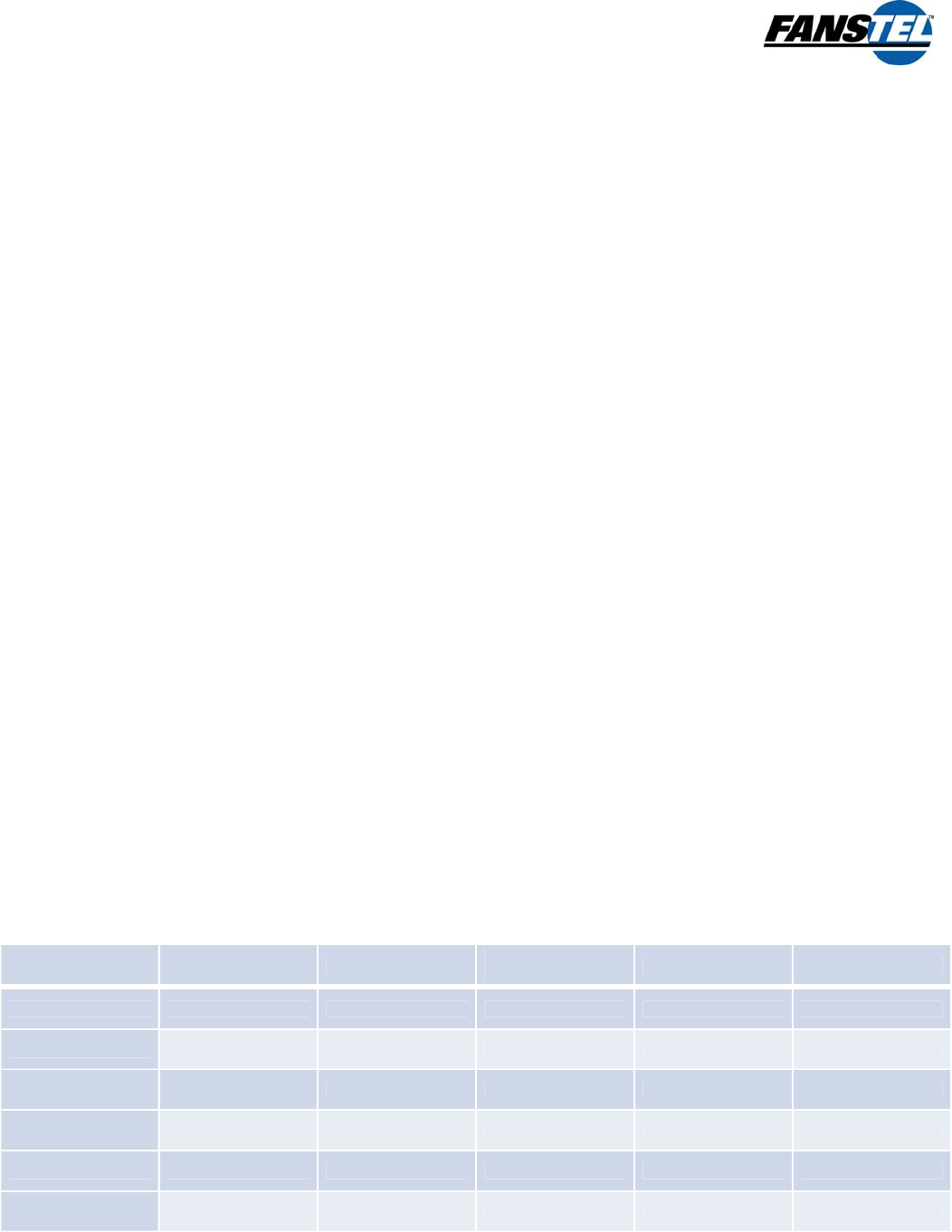
BlueFanBH661C,DualModeBluetoothModuleVer1.00July2016draft
7
✦ Character timeout
✦ Overrun error
✦ Framing error
TC35661 UART interface is used to transfer control command and data and is multiplexed with GPIO
pin. After to release reset state, TC35661 software sets UART interface to related GPIO pins.The
default bit rate depends on the selection ROM version. (e.g. TC35661-503: 115,2kbps)
Flow Control Function
TC35661 UART interface uses flow control function by hardware signal, Transmit flow control (CTSX)
and receive flow control (RTSX). Above Figure shows signals input and output direction .
CTSX input signal is used for UART transmitting. Low input indicates close of the preparation of the
other party to receive data and TC35661 executes UART transmitting data if there is data for
transmission. In case of input high level, TC35661 stops transmitting by UART frame.
RTSX input signal is used for UART receiving. Low output indicates request data transmission to
UART transmitside device of the other party. TC35661 outputs Low level from RTSX when being able
to receive data and prepares to receive data.Response time of UART transmitting and receiving for
flow control signal depends on baud rate and internal process status of frame. It is from 1 frame to 4
frames.
Response time of UART transmitting and receiving for flow control signal depends on baud rate and
internal process status of frame. It is from 1 frame to 4 frame.
UART Baud Rate Setting
TC35661 UART interface has a programmable baud rate setting function. The UART baud rate can
be set according to the following equation. The baud rate generating clock frequency is set to either
39 MHz or 52 MHz. The over-sampling number is set to an integer that range from 1 to 65535.
UART Baud Rate = Baud rate generating clock frequency/(Over sampling number x dividing ratio)
The following table shows examples of UART baud rate setting. The maximum actual baud rate is
4,333,333 bps.
Target baud rate[bps] Actual baud rate[bps] clock(MHz) Over-sampling
number Dividing ratio Deviation[%]
115,200 116,071 39 12 28 0.7564
115,200 116,071 52 14 32 0.7564
921,600 928,571 39 14 3 0.7564
921,600 928,571 52 14 4 0.7564
1,843,200 1,875,143 52 14 2 0.7564
2,764,800 2,785,714 39 14 1 0.7564
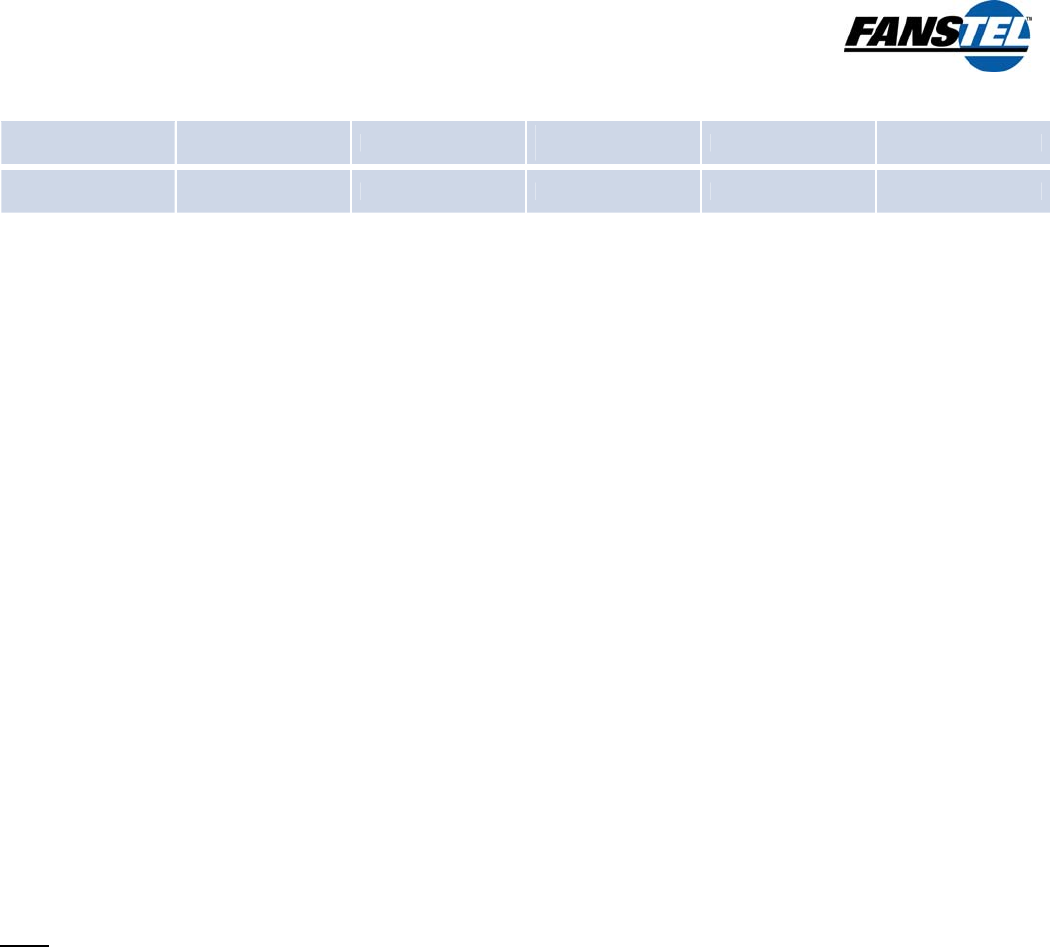
BlueFanBH661C,DualModeBluetoothModuleVer1.00July2016draft
8
Target baud rate[bps] Actual baud rate[bps] clock(MHz) Over-sampling
number Dividing ratio Deviation[%]
4,329,600 4,333,333 52 12 1 0.0862
Error Detect Function
TC35661 UART interface has 3 kinds of error functions.
• Receiver timeout error
• Receiver over run error
• Receiver frame error
Receiver timeout error reports as an error if the receiver frame interval counted by TC35661internal
timer is equal to or greater than a predetermined time
Receiver over run error is reported if UART internal receive frame buffer TC35661 isoverflowed.
Receiver frame error is reported if it fails to recognize the unit frame.
5. Bluetooth Features
BH661C-503
• Bluetooth 4.0 with SPP & GATT
• GAP support for SPP
• GATT Server and Client Mode are supported for LE
• Class 2 TX power w/o external PA, improving link robustness.
• Excellent link budget (up to 91 dB), enabling long-range applications.
• GAP peripheral support for LE.
Note:
• For GAP Broadcaster and Peripheral role are supported
• Observer and Central is not supported on GAP
• For GATT Server and Client Mode are supported
BH661C-008
• Bluetooth Classic supporting wide band voice
• Headset profile (HSP)
• Handsfree profile (HFP)
• Class 2 TX power w/o external PA, improving link robustness.
• Excellent link budget (up to 91 dB), enabling long-range applications.
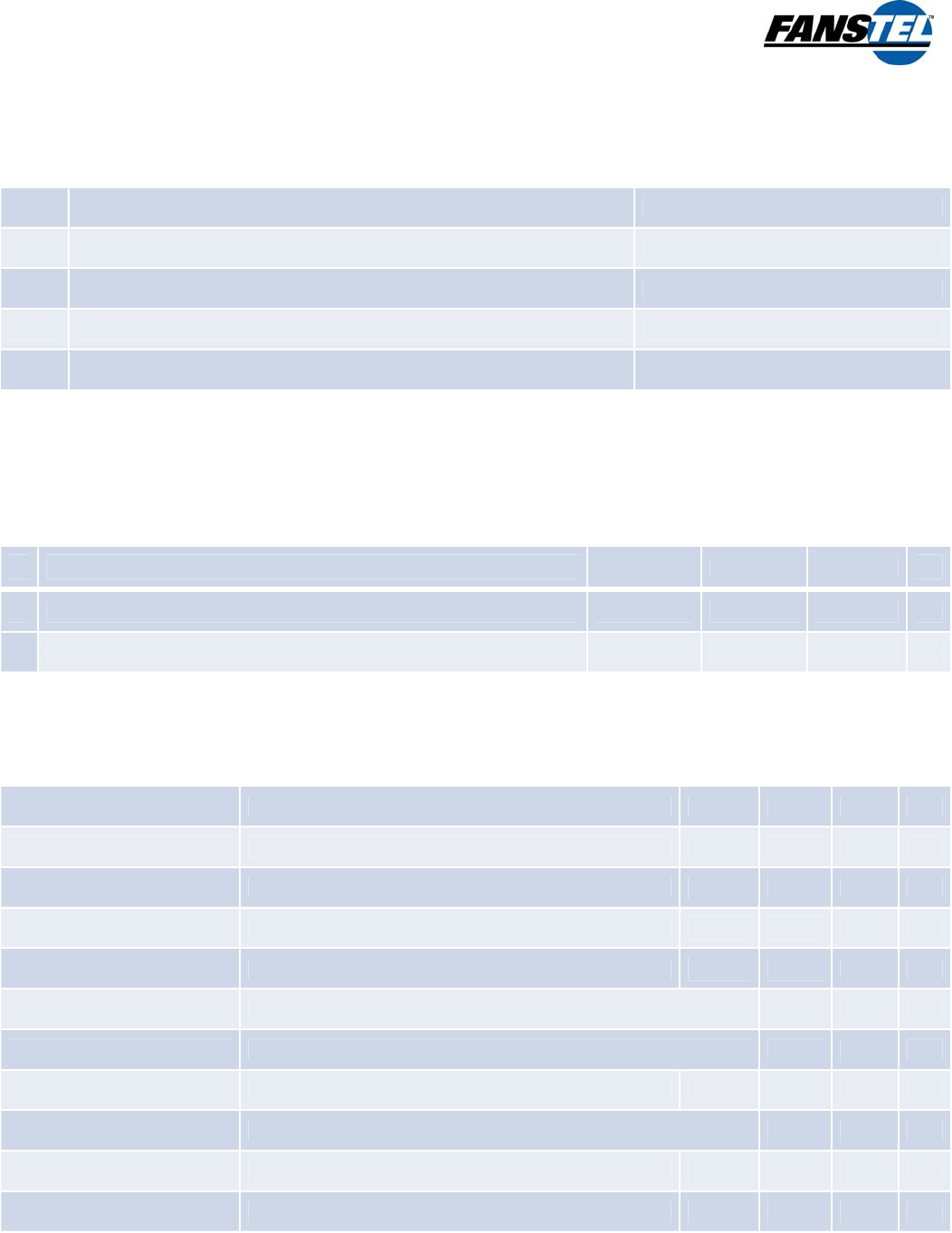
BlueFanBH661C,DualModeBluetoothModuleVer1.00July2016draft
9
6. General Device Requirements and Operation
Absolute Maximum Ratings
1 Voltageonanydigitalpin VDD+/‐0.3V
2 Operatingambienttemperaturerange –40to85°C
3 Storagetemperaturerange –40to125°C
4 BluetoothRFinputs 10dBm
Recommended Operating Conditions
Min Typ Max
1 Powersupplyvoltage 1.7 3.3 3.6 V
2 Maximumambientoperatingtemperature ‐40 85 °C
Current Consumption
Parameters Condition Min Typ Max mA
IdleCurrent Afterresetwaspulleddown. 7.8 mA
ConnectedPeakPower SendingDH5packets.Max.outputpower 62 mA
ConnectedPeakPower SendingDH3packets.Max.outputpower 61 mA
ConnectedPeakPower SendingDH1packets.Max.outputpower 55 mA
SniffMode SniffInterval=1280ms,Attempt=4,timeout=0 0.18 mA
SniffMode SniffInterval=500ms,Attempt=4Timeout=0 0.41 mA
Paging PageScaninterval=1280ms,window=11ms 0.33 mA
Inquiry InquiryScaninterval=1280ms,window=11ms 0.33 mA
BLEAdvertising(1Packet) Advertisinginterval=30ms 5.8 mA
BLEAdvertising(1Packet) Advertisinginterval=1280ms 0.165 mA

BlueFanBH661C,DualModeBluetoothModuleVer1.00July2016draft
10
BLEConnected(1Packet) Connectioninterval=105ms 0.913 mA
BLEConnected(1Packet) Connectioninterval=1000ms 0.123 mA
7. Software
Information Regarding Software Versions
The version number of the embedded software can be read out by an extended HCI command. The
extended HCI command class < HCI_M2_Message_Get >" allows the reading of the firmware
version. PC and MAC software to send HCI commands to read module software version is available
from http://www.fasntel.com.
Software
The module software offers both embedded Bluetooth HCI (Host Control Interface), extended HCI
and TCU (Toshiba Control Unit) Command interfaces via the embedded UART interface
(1) HCI commands are standard according to Bluetooth standard specifications.
(2) Extended HCI commands are available for device control, such as RF control, BD_ADDR control,
firmware version control, embedded IO control, maintenance tasks etc. Please refer to the
“Extension HCI Command Document”.
(3) The BH661-502 includes Toshiba TC35661 with ROM code 502 incorporating Bluetooth stack and
SPP profile and BLE GATT profile. The profile application interface is described in the “SPP
Command Interface Document” (about 14 commands) and the “Bluetooth Basic Management
Command Interface Document” (about 46 commands). The related high level commands are
called “TCU” commands.The “SPP Message Sequence Chart Document” and the “Bluetooth
Management Message . Sequence Chart Document” describe the logical and sequential
procedure to use those commands.
(4) The BH661-008 includes Toshiba TC35661 with ROM code 008 incorporating Bluetooth
Handsfree profile and Headset profile. The profile application interface is described in the
“Bluetooth Basic Management Command Interface Document” (about 46 commands). The related
high level commands are called “TCU” commands.
(5) After RESET of the module, the module starts in HCI mode. The “Bluetooth LSI TC35661
Application Note” describes how to start the device and enter into “TCU” mode thereafter.
(6) Toshiba offers SPP drivers, that allows a further abstraction towards the application software
including SPP programming examples. This is documented in the “BT SPP API Specification”,
the ”BT SPP Driver Specification” and the “BT SPP Application Note”. The“SPP API” offers a few
high-level APIs for LSI initialization, connection setup and communication with a remote SPP
device. The user has full control over all LSI features by utilizing the lower-level“SPP Drivers”. The
drivers take care for issuing commands and data to the LSI and they handle the responses from
the TC36661. The “Application Note” includes a SPP programming exampleand shows the integration
with a RTOS.”All documents are available on respective Fanstel or Toshiba websites.
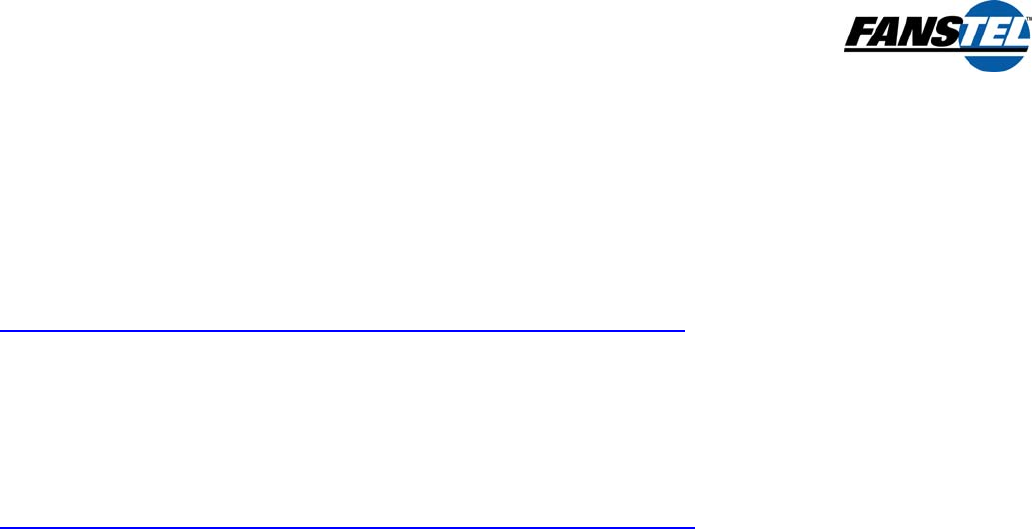
BlueFanBH661C,DualModeBluetoothModuleVer1.00July2016draft
11
8. BH661C Evaluation Board
A quick and easy way to evaluate BH661C is to use a Windows PC or a MAC as the host processor.
Connect the development board DVB661C to a PC with an USB cable.
Evaluation Software for Windows PC
Evaluation software for Windows PC can be download from the following link.
https://dl.dropboxusercontent.com/u/54939426/BlueFanHCIwin.rar
After unzipping, it becomes an executable file. You need to OPEN from a MENU for the first time.
Then, you can double click the icon to open.
Evaluation Software for MAC
Evaluation software for MAC can be download from the following link.
https://dl.dropboxusercontent.com/u/54939426/BlueFanHCImac.zip
After unzipping, it becomes an executable file. You need to OPEN from a MENU for the first time.
Then, you can double click the icon to open
Android OS App
Android OS apps to evaluate communication via SPP and BLE can be downloaded from Google Play
Store by searching for BlueFan. This is a very basic app for proving communication between a PC,
BH661 module, and an Android device.
iOS App
iOS apps to evaluate communication via BLE can be downloaded from Apple App Store by searching
for BlueFan. This is a very basic app for proving communication between a PC, BH661 module, and
an Android device.
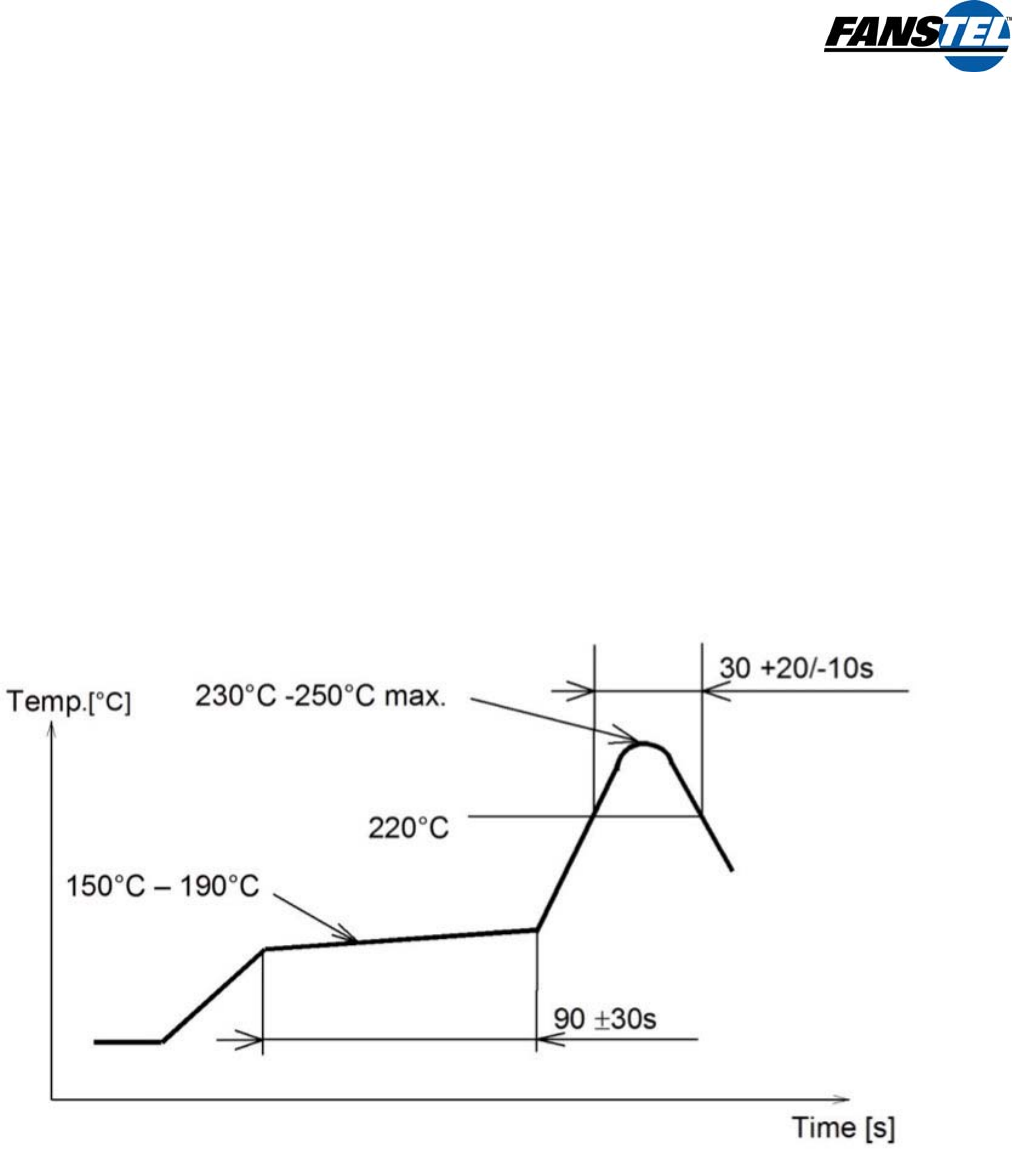
BlueFanBH661C,DualModeBluetoothModuleVer1.00July2016draft
12
9. FCC
(1) the module should not installed and operated simultaneously with other radios except additional
RF exposure was evaluated and meeting FCC requirement for simultaneously transmission.
(2) Antenna used should be limited to (Dipole) type with equal or lesser antenna gain.
10. Soldering Temperature-Time Profile for Re-Flow Soldering
The following temperature profile is suggested for re-flow oven.
11. Cautions
Failure to follow the guidelines set forth in this document may result in degrading of the
product’sfunctions and damage to the product.
Design Notes
(1) Follow the conditions written in this specification, especially the control signals ofthis module.

BlueFanBH661C,DualModeBluetoothModuleVer1.00July2016draft
13
(2) The supply voltage has to be free of AC ripple voltage (for example from a battery or a low noise
regulator output). For noisy supply voltages, provide a decoupling circuit (for example a ferrite in
series connection and a bypass capacitor to ground of at least 47uF directly at the module).
(3) This product should not be mechanically stressed when installed.
(4) Keep this product away from heat. Heat is the major cause of decreasing the life of these
products.
(5) Avoid assembly and use of the target equipment in conditions where the products' temperature
may exceed the maximum tolerance.
(6) The supply voltage should not be exceedingly high or reversed. It should not carry noise and/or
spikes.
(7) this product away from other high frequency circuits.
Notes on Antenna and PCB Layout
(1) Don’t use a module with internal antenna inside a metal case.
(2) Use a module with external antenna inside a metal case. Antenna must be outside of a metal case.
(3) For PCB layout:
• Avoid running any signal line below module whenever possible,
• No ground plane below antenna,
• If possible, cut-off the portion of main board PCB below antenna.
Installation Notes
(1) Reflow soldering is possible twice based on the time-temperature profile in this data sheets.Set up
the temperature at the soldering portion of this product according to this reflow profile.
(2) Carefully position the products so that their heat will not burn into printed circuitboards or affect the
other components that are susceptible to heat.
(3) Carefully locate these products so that their temperatures will not increase due tothe effects of
heat generated by neighboring components.
(4) If a vinyl-covered wire comes into contact with the products, then the cover will melt and generate
toxic gas, damaging the insulation. Never allow contact between the cover and these products to
occur.
(5) This product should not be mechanically stressed or vibrated when reflowed.
(6) If you want to repair your board by hand soldering, please keep the conditions of this chapter.
(7) Do not wash this product.
(8) Refer to the recommended pattern when designing a board.

BlueFanBH661C,DualModeBluetoothModuleVer1.00July2016draft
14
(9) Pressing on parts of the metal cover or fastening objects to the metal will cause damage to the
unit.
(10) For more details on LGA (Land Grid Array) soldering processes refer to the application note.
Usage Condition Notes
(1) Take measures to protect the unit against static electricity. If pulses or other transient loads (a
large load applied in a short time) are applied to the products, check and evaluate their operation
before assembly on the final products.
(2) Do not use dropped products.
(3) Do not touch, damage or soil the pins.
(4) Follow the recommended condition ratings about the power supply applied to thisproduct.
(5) Electrode peeling strength: Do not add pressure of more than 4.9N when soldered on PCB
(6) Pressing on parts of the metal cover or fastening objects to the metal cover will cause
damage.
(7) These products are intended for general purpose and standard use in general electronic
equipment, such as home appliances, office equipment, informationand communication equipment.
Storage Notes
(1) The module should not be stressed mechanically during storage.
(2) Do not store these products in the following conditions or the performancecharacteristics of the
product, such as RF performance will be adverselyaffected:
• Storage in salty air or in an environment with a high concentration of corrosive gas.
• Storage in direct sunlight
• Storage in an environment where the temperature may be outside the range specified.
• Storage of the products for more than one year after the date of delivery storage period.
(3) Keep this product away from water, poisonous gas and corrosive gas.
(4) This product should not be stressed or shocked when transported.
(5) Follow the specification when stacking packed crates (max. 10).
Safety Conditions
These specifications are intended to preserve the quality assurance of products and individual
components. Before use, check and evaluate the operation when mounted on your products. Abide by
these specifications, without deviation when using the products. These products may short-circuit. If
electrical shocks, smoke, fire, and/or accidents involving human life are anticipated when a short
circuit occurs, then provide the following failsafe functions, as a minimum.

BlueFanBH661C,DualModeBluetoothModuleVer1.00July2016draft
15
(1) Ensure the safety of the whole system by installing a protection circuit and a protection device.
(2) Ensure the safety of the whole system by installing a redundant circuit or anothersystem to
prevent a dual fault causing an unsafe status.
Other Cautions
(1) This specification sheet is copyrighted. Reproduction of this data sheets is permissible only if
reproduction is without alteration and is accompanied by all associated warranties, conditions,
limitations, and notices.
(2) Do not use the products for other purposes than those listed.
(3) Be sure to provide an appropriate faisafe function on your product to prevent anadditional
damage that may be caused by the abnormal function or the failure of the product.
(4) This product has been manufactured without any ozone chemical controlled under the
Montreal Protocol.
(5) These products are not intended for other uses, other than under the special conditions shown
below. Before using these products under such special conditions, check their performance and
reliability under the said special conditions carefully to determine whether or not they can be used
in such a manner.
• In liquid, such as water, salt water, oil, alkali, or organic solvent, or in places where liquid may
splash.
• In direct sunlight, outdoors, or in a dusty environment
• In an environment where condensation occurs.
• In an environment with a high concentration of harmful gas.
(6) If an abnormal voltage is applied due to a problem occurring in other componentsor circuits,
replace these products with new products because they may not beable to provide normal
performance even if their electronic characteristics and appearances appear satisfactory.
(7) When you have any question or uncertainty, contact Fanstel.
12. Packaging
We will deliver the module in the described below.
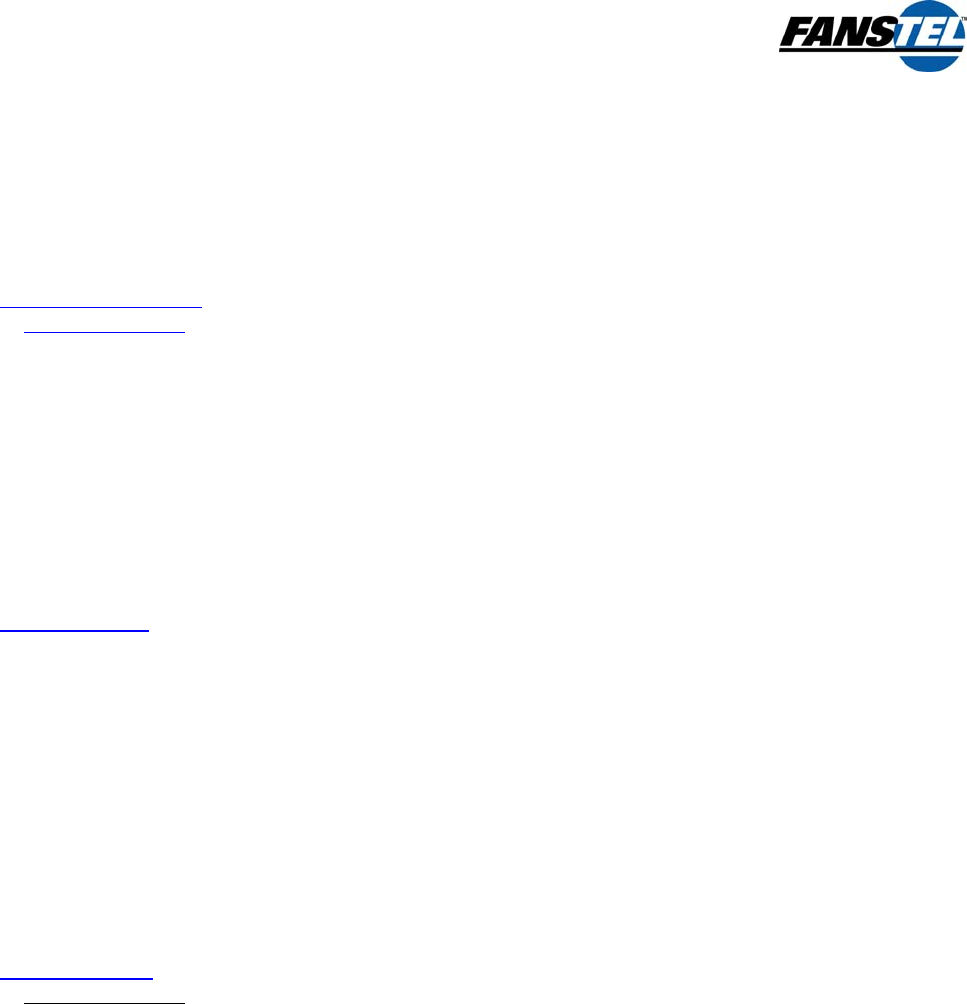
BlueFanBH661C,DualModeBluetoothModuleVer1.00July2016draft
16
13. CONTACT US
United States:
Fanstel Corp.
7466 E. Monte Ctisto Ave. Scottsdale AZ 85260
Tel. 1 480-948-4928
Fax. 1-480-948-5459
Email: module@fanstel.com
Website: www.fanstel.com
Taiwan:
Fanstel Corp.
10F-10, 79 Xintai Wu Road
Xizhu, New Taipei City, Taiwan 22101
泛世公司
臺灣省新北市汐止區新臺五路 79 號10 樓之 10, 22101
Tel. 886-2-2698-9328
Fax. 886-2-2698-4813
Email: tp@fanstel.com
Website: www.fanstel.com
China:
Fanstel Technologies Corp.
11 Jiale Street
Ping-Dih, Long-Gang, Shen Zhen, GD 518117
泛世康科技(深圳)有限公司
廣東省深圳市龍崗區坪地鎮佳樂街 11 號
Tel. 86-755-8409-0928
Fax. 86-755-8409-0973
QQ. 3076221086
Email: sz@fanstel.com
Website: www.fanstel.com

BlueFanBH661C,DualModeBluetoothModuleVer1.00July2016draft
17
Federal Communications Commission (FCC) Statement
15.21
You are cautioned that changes or modifications not expressly approved by the part responsible for compliance
could void the user’s authority to operate the equipment.
15.105(b)
This equipment has been tested and found to comply with the limits for a Class B digital device, pursuant to part
15 of the FCC rules. These limits are designed to provide reasonable protection against harmful interference in a
residential installation. This equipment generates, uses and can radiate radio frequency energy and, if not
installed and used in accordance with the instructions, may cause harmful interference to radio communications.
However, there is no guarantee that interference will not occur in a particular installation. If this equipment does
cause harmful interference to radio or television reception, which can be determined by turning the equipment
off and on, the user is encouraged to try to correct the interference by one or more of the following measures:
-Reorient or relocate the receiving antenna.
-Increase the separation between the equipment and receiver.
-Connect the equipment into an outlet on a circuit different from that to which the receiver is connected.
-Consult the dealer or an experienced radio/TV technician for help.
This device complies with Part 15 of the FCC Rules. Operation is subject to the following two conditions:
1) this device may not cause harmful interference, and
2) this device must accept any interference received, including interference that may cause undesired operation
of the device.
FCC RF Radiation Exposure Statement
1) This Transmitter must not be co-located or operating in conjunction with any other antenna or transmitter.
2) This equipment complies with FCC RF radiation exposure limits set forth for an uncontrolled environment.
This equipment should be installed and operated with a minimum distance of 20 centimeters between the
radiator and your body.
To comply with FCC regulations limiting both maximum RF output power and human exposure to RF radiation,
the maximum antenna gain including cable loss in a mobile-only exposure condition must not exceed chip
Ant / 1.6dBi
Note: The end product shall has the words “Contains Transmitter Module FCC ID:X8WBH661
Canada, Industry Canada (IC)
This Class B digital apparatus complies with Canadian ICES-003
Cet appareil numérique de classe B est conforme à la norme NMB-003.

BlueFanBH661C,DualModeBluetoothModuleVer1.00July2016draft
18
This device complies with Industry Canada licence-exempt RSS standard(s). Operation is subject
to the following two conditions: (1) this device may not cause interference, and (2) this device
must accept any interference, including interference that may cause undesired operation of the
(Modular approval) End Product Labeling:
The final end product must be labeled in a visible area with the following: “Contains IC:4100A-BH661”.

BlueFanBH661C,DualModeBluetoothModuleVer1.00July2016draft
19
Caution: Exposure to Radio Frequency Radiation.
To comply with RSS 102 RF exposure compliance requirements, a separation distance of at least 20 cm must be
maintained between the antenna of this device and all persons.
Pour se conformer aux exigences de conformité CNR 102 RF exposition, une distance de séparation d'au moins
20 cm doit être maintenue entre l'antenne de cet appareil et toutes les personnes
To comply with IC regulations limiting both maximum RF output power and human exposure to RF radiation,
the maximum antenna gain including cable loss in a mobile-only exposure condition must not internal chip Ant /
1.6dBi
OEM: instruction
Information for the OEMs and Integrators
The following statement must be included with all versions of this document supplied to an
OEM or integrator, but should not be distributed to the end user.
This device is intended for OEM integrators only.Please See the full Grant of Equipment document for other
restrictions.
Information To Be Supplied to the End User by the OEM or Integrator
The following regulatory and safety notices must be published in documentation supplied to the end user of the
product or system incorporating an adapter in compliance with local regulations. Host system must be labeled
with "Contains FCCID: X8WBH661 “, FCC ID displayed on label